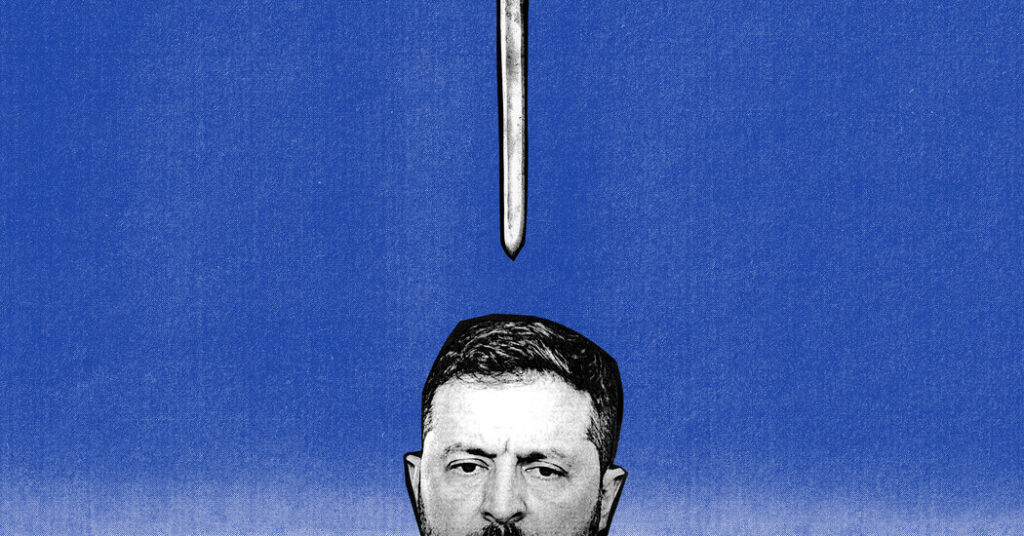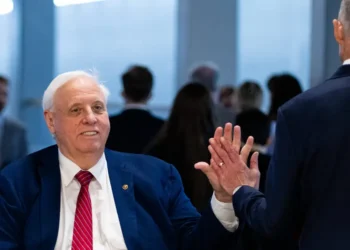I have profoundly mixed feelings about the peace talks now underway to end the war in Ukraine.
On one hand, the emerging military realities should tell us that this is exactly the right time to negotiate a cease-fire. The question, however, is whether Russia and, sadly, the United States are willing to agree to a just peace — one that keeps Ukraine free.
But first, before we dive into the possibility of peace, let’s talk about the facts on the ground.
Ukraine is under immense pressure. Russia is attacking relentlessly along the front in eastern Ukraine, and Ukraine is on the verge of losing an important battle — the city of Pokrovsk is in imminent danger of falling, and there is real concern that Ukrainian troops could get surrounded and trapped if Russia is able to take the city.
With its so-called Rubicon drone units, Russia has revamped its drone tactics and now might even be outpacing Ukraine in tactical innovation. The Russian war economy is producing huge numbers of Shahed drones — which Russia uses to attack Ukrainian cities and towns — and Ukrainian air defenses now face enormous swarms of attacking drones and missiles.
Ukrainian cities are being battered. The Ukrainian energy sector is under siege. At the same time, American financial support has almost disappeared (though we are still selling weapons purchased by Europe for use in Ukraine), and President Volodymyr Zelensky’s government is mired in a corruption scandal (in which a number of Zelensky’s close allies have been accused of receiving kickbacks from a Ukrainian nuclear power company) that’s weakened his political standing, arguably to its lowest point since the war began.
But Russia is also under immense pressure. By any fair measure, its summer offensive — which continues into the fall — has been a costly disappointment. It has gained ground, but at a staggering cost. Russia has almost certainly suffered more than a million total casualties in the war so far, and — as Edward Carr explained in The Economist — at the present rate of advance it would take five more years for Russia to take the four oblasts (provinces) it’s seeking to conquer and cost a total of almost four million casualties.
In fact, as Michael Kofman, a senior fellow at the Carnegie Endowment for International Peace who is one of the foremost Western analysts of the war, has reported, Russia’s unrecoverable casualties are approaching its rate of recruitment. In other words, it is focused on replacing losses rather than expanding the force. Its new recruits are lower in quality, and desertion is a problem.
And while Russia has innovated tactically, there are no immediate prospects for a breakthrough. These new tactics involve infiltrating through Ukrainian lines in small groups at terrible cost — often on motorcycles and all-terrain vehicles — and then trying to build on the small footholds that they are able to achieve.
It’s a tactic that works for incremental advances, but there’s no feasible way (at least not yet) for Russia to shatter Ukrainian lines. Given the drone swarms that saturate the front, large-scale movements of tanks or troops are almost always immediately spotted and attacked with drones and artillery.
At the same time, Ukraine has improved its long-range attack capabilities, both with Western-supplied weapons and with its own home-built drones and missiles. Ukraine has systematically targeted Russian energy infrastructure and oil refineries.
If you put all this together, you know that neither side seems to have any real hope of changing the underlying dynamics of the war. The Russians push forward, inch by inch. The Ukrainians make them bleed for every advance, and each side looks to the other to finally crack under pressure, collapse, and yield.
That’s the immediate backdrop to the peace negotiations that kicked off in Geneva and continued elsewhere, but there’s an additional reality, one that I learned when I talked to Ukrainian leaders during my visit to the country in 2023. “We’re going to have to fight three wars,” a senior member of the government told me, “and this is only the second.”
The first war, in this telling, was the Russian invasion of Crimea and parts of the Donbas region in 2014. The second war is the one raging now, the war that began with Russia’s attack on Feb. 24, 2022. The third war is the next war — the one that Ukraine fears Russia will launch once it has had a chance to pause and rearm.
Winning, or better yet deterring, that third war is one of Ukraine’s chief concerns. That’s why, for example, Zelensky has signed letters of intent to purchase hundreds of advanced fighters from France and Sweden, even though deliveries won’t be complete for at least a decade.
A free and independent Ukraine will be no more tolerable to President Vladimir Putin after a cease-fire than it was before, and any peace agreement now has to be evaluated on the basis of a single key question — can Ukraine remain free after the shooting stops?
That’s the core problem with the leaked 28-point peace plan that the Trump administration tried to impose on Ukraine earlier this month. Even if you assume that Ukraine might be willing to trade some land for peace (a cease-fire on current lines, for example), it still must retain the means of preserving its political independence, or any peace agreement is little more than a surrender document.
Trump’s initial plan yielded all of the Donbas to Russia — including the parts of Donbas that Russia hasn’t been able to seize from Ukraine — and tried to force Ukraine to accept a cap of 600,000 military personnel, a number substantially smaller than its current force. There is no chance that a mere 600,000 men and women could hold the long border against a vastly larger Russian force.
The plan contains no corresponding limitations on Russia’s much larger force. Russia has more than 1.3 million active duty troops, and it’s planning to expand the military to a total of 1.5 million. In other words, Trump’s plan would shrink the Ukrainian military at the same time that Putin is increasing the size of Russia’s force. The resulting power imbalance would be extreme.
At the same time, Ukraine would have to give up the prospect of joining NATO, and NATO troops could not be stationed on Ukrainian soil. As a result, any security guarantee in the agreement would be paper guarantees only, and Ukraine knows from bitter experience that a mere paper guarantee is no guarantee at all.
It’s no wonder, then, that Zelensky had an immediate negative reaction — casting the plan as a choice between losing Ukrainian dignity and losing American support. But given the battlefield situation, combined with the possibility of losing American aid, it’s also no wonder that Ukraine feels intense pressure to try to strike a deal of some kind. The only way that Ukraine can stay in the fight over the long term is to rely on the United States and Europe to function as arsenals of democracy, matching Russian industrial might with their own production and their own weapons.
If Ukraine loses American aid — as Zelensky plainly fears — it’s unclear that Europe can pick up the slack over the long term, especially as the European powers rush to rearm their own militaries. Without steadfast American support, Ukraine could well face two terrible choices — accept the Russian/American deal and live as Moscow’s vassal, or reject the deal and face a doomed struggle against a superior force.
And so Ukraine is negotiating. On Monday, The Financial Times reported that a U.S. delegation led by Secretary of State Marco Rubio met with their Ukrainian counterparts and hammered out a Ukrainian/American counterproposal to the Russian/American initial plan, including a potential increase of the Ukrainian troop cap to 800,000 (a number much closer to its present strength).
But the very elements that make a deal acceptable to Ukraine — such as ensuring that Ukraine has the ability to protect itself against renewed Russian aggression — are the same things that make it unacceptable to Russia. Its true war aims have never been solely about territory. Yes, it obviously seeks to exercise sovereignty over the Donbas, but it also wants Ukraine to be a rump state, a larger version of Belarus, a nation that is entirely in thrall to Putin’s Russia.
Putin doesn’t even view Ukraine as a legitimate country. He refuses to see Ukraine as a distinct nation with a distinct culture and history. For him, the only satisfactory conclusions to the war involve either the extinction of Ukraine or its total domination by Russia.
Ukraine might be too weak to retake the Donbas, but more than three years of war have taught us that Russia isn’t strong enough to take Ukraine. And since Ukraine understands that it can’t recapture the Donbas, the true path to peace lies in convincing Putin that he can’t seize control of Ukraine.
The fundamental objective of American diplomacy and the fundamental aim of American aid should be to deny Putin control of Ukraine. Rubio seems to understand this imperative, but much of the rest of the administration does not.
If Trump uses the considerable economic, military and diplomatic power of the United States to coerce Ukraine into risking its independence, a cease-fire wouldn’t be a diplomatic achievement — it would be a national shame.
Actually, it would be worse than that. It would be a strategic disaster. We’d teach our NATO allies that we’re an unreliable partner, we’d teach Vladimir Putin that brute military force works, and we’d place NATO’s eastern flank at profound, immediate risk. We would have increased the chances of a wider war.
Russia can win the war two ways. It can continue to try to defeat Ukraine on the battlefield at immense cost. It can inch forward, day by day, in the hopes that someday Ukraine will finally collapse. But that course of action carries considerable risk. In the face of such horrific casualties, one wonders how long Russian society can carry that cost. The long stalemate in Afghanistan contributed to the fall of the Soviet Union, for example, and Russia is fighting a bloodier, much more costly war now. It’s far from clear that it can maintain its current military operations indefinitely.
The second way that Russia can win is by leveraging American influence to pressure Ukraine into concessions that Russia could not win — and has not won — on the battlefield. And Putin has far more hope in the short term that he can influence America than he can break through in the Donbas.
We can breathe a sigh of relief, at least for now, that Ukrainian diplomacy seems to have yielded a new plan, one that reportedly contains key differences with the old.
In fact, there is even a degree of confusion as to whether the initial Russian/American plan had any American elements at all, or if it was simply a Russian plan delivered through the United States. Senator Mike Rounds, a Republican, said at a news conference that Secretary of State Rubio “made it very clear to us that we are the recipients of a proposal that was delivered to one of our representatives.”
“It is not our recommendation,” Rounds said, “It is not our peace plan. It is a proposal that was received, and as an intermediary, we have made arrangements to share it — and we did not release it. It was leaked.”
Rubio, however, tweeted, “The peace proposal was authored by the U.S. It is offered as a strong framework for ongoing negotiations. It is based on input from the Russian side. But it is also based on previous and ongoing input from Ukraine.”
All this confusion led Donald Tusk, the prime minister of Poland and leader of a nation that has experienced recent Russian drone incursions, to respond with a tweet of his own — “Together with the leaders of Europe, Canada and Japan, we have declared our readiness to work on the 28-point plan despite some reservations. However, before we start our work, it would be good to know for sure who is the author of the plan and where it was created.”
This is not how American diplomacy should be done. Our support for Ukraine should be steadfast. Russia should be made to understand that we will not force Ukraine to yield its independence, and American arms and American support mean that Russia will continue to bleed itself dry if it pursues its maximal demands.
At the same time, however, we have to deliver a hard message to Ukraine. Some of its territory is lost — perhaps not forever, but for the foreseeable future. Yet it has not shed its blood in vain.
When this all started, it was predicted that Ukraine would collapse in hours or days, but it has stood strong, inflicting devastating losses on one of the world’s most powerful nations. It would be an intolerable and catastrophic failure if the Trump administration delivers Putin a victory through diplomacy that he could not achieve in war.
Some other things I did
My Sunday column was about the laws of war, illegal orders and Trump’s absurd (and dangerous) overreaction to a video featuring six Democratic lawmakers that simply said members of the military must not obey illegal commands:
Trump has put the military in an impossible situation. He’s making its most senior leaders complicit in his unlawful acts, and he’s burdening the consciences of soldiers who serve under his command. One of the great moral values of congressional declarations of war is that they provide soldiers with the assurance that the conflict has been debated and that their deployment is a matter of national will.
When the decision rests with the president alone, it puts members of the military in the position of trusting the judgment of a person who may not deserve that trust. I have heard from several anguished members of the active duty military. They feel real moral doubt and are experiencing profound legal confusion.
So here’s the bottom line: No legal opinion can compel any member of the military to commit “manifestly unlawful” acts during a war. But when it comes to the decision to begin an armed conflict, the responsibility doesn’t rest with individual soldiers, sailors, airmen or Marines; it rests with Trump and his most senior military and political advisers — the men and women who ordered them to fight.
Thank you for being a subscriber
If you’re enjoying what you’re reading, please consider recommending it to others. They can sign up here. Browse all of our subscriber-only newsletters here.
Have feedback? Send me a note at [email protected].
You can also follow me on Threads (@davidfrenchjag).
The post ‘We Are Going to Have to Fight Three Wars’ appeared first on New York Times.




